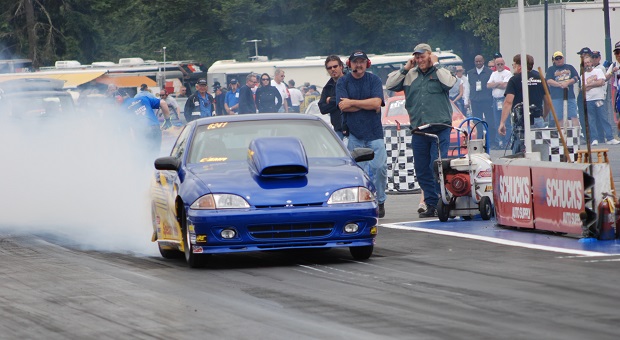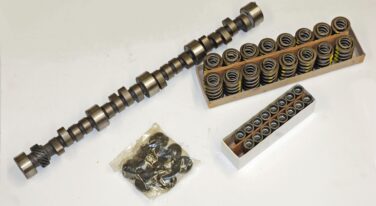
Picking the Right Ignition Coil, Part 2
Click Here to Begin Slideshow
In our last issue we dug into high performance race coils. To recap, coils are usually sold by voltage, turn ratio and induction specifications. But that doesn’t mean bigger is better. Not all coils are appropriate for a given application or a given ignition system. That’s very important. That's why companies such as MSD Ignition offer a wide range of coils – each aimed at a specific task. What follows is a look at several common MSD coils suitable for drag race only as well as street-strip applications (in conjunction with specific ignition boxes). Check it out:
8207 Coil: MSD’s Blaster SS coil is compact in size; however, the E-core configuration is engineered to produce considerable power. The turn ratio is 70:1 while the maximum output voltage is 40,000. According to MSD, “The secondary windings are wound on a segmented bobbin which reduces the chance of voltage breakdown between the primary and secondary windings. For more protection, these windings are encased in a polyurethane compound for complete protection against vibration.”
Externally, the Blaster SS coil is built with a tough, finned Rynite housing. Terminals are brass and the secondary wire tower is tall and offset to one side. This coil is optimized for street-strip use on MSD 6-series ignition control boxes. Complete specifications are as follows:
Inductance: 6.9mH
Maximum Voltage: 40,000 Volts
Primary Resistance: .355 OHMS
Secondary Resistance: 4.4K OHMS
Spark Duration: 220 uS
Turns Ratio: 70:1
8251 Coil: When it comes to high performance coils, many tend to be a compromise between voltage output and current output. MSD notes that more voltage increases the initial ionization of the spark plug gap, but lowers the amount of current, or heat, that follows across the plug gap. When a specific coil is designed to produce more current, MSD tells us the voltage output generally suffers. The end result is difficulty ionizing the gap.
The secret to getting more current and more voltage is the use of an E-core winding configuration. This is a very efficient design where less loss occurs during the transfer of electricity due to the closed core of the coil. Equally important is the fact that these coils run extremely cool, even at high racing rpm.
The Pro Power HVC (High Voltage/Current) coil is designed for applications with an MSD 7 Series ignition control box. It features a turn ratio of 85:1. The windings are encased in red epoxy and secured with extruded brackets. Meanwhile, the coil features brass primary connection terminals as well as a brass tower-style secondary terminal.
Specs are as follows:
Inductance: 1 mH
Maximum Voltage: 45,000 Volts
Peak Current: 1.1 Amp
Primary Resistance: .04 OHMS
Secondary Resistance: 86 OHMS
Spark Duration: 150 uS
Turns Ratio: 85:1
8253 Coil: The Blaster HVC coil is manufactured as an iron U-Core configuration with a segmented bobbin for improved voltage distribution. The secondary portion of the coil is wound on a special DuPont Rynite material bobbin that has been divided into sections or bays. The wire used in the secondary is much finer than the wire found on the primary windings. By using this configuration, MSD can produce the most current possible with very high voltage and extremely quick rise time with the coil.
MSD notes that the blue housing on the coil is also molded from high dielectric Rynite material. The brass primary terminals are spaced far apart and the secondary tower is well protected for increased spark isolation. The housing is completely potted with an epoxy compound for vibration resistance and installs with sturdy vibration mounts.
This particular coil is designed for use with MSD 6-series ignition systems (only) and MSD points out that it can be used for high RPM and long duration applications (translated: Street-Strip applications).
MSD specs are as follows:
Inductance: 3.5 mH
Maximum Voltage: 44,000 Volts
Peak Current: 450 mA
Primary Resistance: .16 OHMS
Secondary Resistance: 630 OHMS
Spark Duration: 450 uS
Turns Ratio: 85:1
8261 Coil: The last coil on our list is MSD’s HVC II Coil. This is an iron U-Core configuration that includes a segmented bobbin. MSD uses DuPont Rynite FR946 material for the bobbin. The reason is it has excellent dielectric capabilities at high temperatures. MSD also incorporates a cutting edge winding material that has an improved insulation and is also capable of enduring extreme voltages.
The coil housing is also moulded from Rynite material. Like the other MSD coils featured here, it makes use of brass primary terminals and a well-protected (shielded) secondary tower for increased spark isolation. MSD also notes that the housing is completely potted with a fracture resistant epoxy compound for vibration resistance. MSD recommends 14-Gauge wire for the primary coil connections.
This coil is designed for use with MSD 7, 8 or 10-Series ignition systems only. Specs are below:
Inductance: .250 mH
Maximum Voltage: 45,000 Volts
Peak Current: 2 Amps
Primary Resistance: .016 OHMS
Secondary Resistance: 30 OHMS
Spark Duration: 150 uS
Turns Ratio: 75:1
###
For a closer look at the above coils, check out the accompanying photos.
In our last issue we dug into high performance race coils. To recap, coils are usually sold by voltage, turn ratio and induction specifications. But that doesn’t mean bigger is better. Not all coils are appropriate for a given application or a given ignition system. That’s very important. That's why companies such as MSD Ignition offer a wide range of coils – each aimed at a specific task. What follows is a look at several common MSD coils suitable for drag race only as well as street-strip applications (in conjunction with specific ignition boxes). Check it out:
8207 Coil: MSD’s Blaster SS coil is compact in size; however, the E-core configuration is engineered to produce considerable power. The turn ratio is 70:1 while the maximum output voltage is 40,000. According to MSD, “The secondary windings are wound on a segmented bobbin which reduces the chance of voltage breakdown between the primary and secondary windings. For more protection, these windings are encased in a polyurethane compound for complete protection against vibration.”
Externally, the Blaster SS coil is built with a tough, finned Rynite housing. Terminals are brass and the secondary wire tower is tall and offset to one side. This coil is optimized for street-strip use on MSD 6-series ignition control boxes. Complete specifications are as follows:
Inductance: 6.9mH
Maximum Voltage: 40,000 Volts
Primary Resistance: .355 OHMS
Secondary Resistance: 4.4K OHMS
Spark Duration: 220 uS
Turns Ratio: 70:1
8251 Coil: When it comes to high performance coils, many tend to be a compromise between voltage output and current output. MSD notes that more voltage increases the initial ionization of the spark plug gap, but lowers the amount of current, or heat, that follows across the plug gap. When a specific coil is designed to produce more current, MSD tells us the voltage output generally suffers. The end result is difficulty ionizing the gap.
The secret to getting more current and more voltage is the use of an E-core winding configuration. This is a very efficient design where less loss occurs during the transfer of electricity due to the closed core of the coil. Equally important is the fact that these coils run extremely cool, even at high racing rpm.
The Pro Power HVC (High Voltage/Current) coil is designed for applications with an MSD 7 Series ignition control box. It features a turn ratio of 85:1. The windings are encased in red epoxy and secured with extruded brackets. Meanwhile, the coil features brass primary connection terminals as well as a brass tower-style secondary terminal.
Specs are as follows:
Inductance: 1 mH
Maximum Voltage: 45,000 Volts
Peak Current: 1.1 Amp
Primary Resistance: .04 OHMS
Secondary Resistance: 86 OHMS
Spark Duration: 150 uS
Turns Ratio: 85:1
8253 Coil: The Blaster HVC coil is manufactured as an iron U-Core configuration with a segmented bobbin for improved voltage distribution. The secondary portion of the coil is wound on a special DuPont Rynite material bobbin that has been divided into sections or bays. The wire used in the secondary is much finer than the wire found on the primary windings. By using this configuration, MSD can produce the most current possible with very high voltage and extremely quick rise time with the coil.
MSD notes that the blue housing on the coil is also molded from high dielectric Rynite material. The brass primary terminals are spaced far apart and the secondary tower is well protected for increased spark isolation. The housing is completely potted with an epoxy compound for vibration resistance and installs with sturdy vibration mounts.
This particular coil is designed for use with MSD 6-series ignition systems (only) and MSD points out that it can be used for high RPM and long duration applications (translated: Street-Strip applications).
MSD specs are as follows:
Inductance: 3.5 mH
Maximum Voltage: 44,000 Volts
Peak Current: 450 mA
Primary Resistance: .16 OHMS
Secondary Resistance: 630 OHMS
Spark Duration: 450 uS
Turns Ratio: 85:1
8261 Coil: The last coil on our list is MSD’s HVC II Coil. This is an iron U-Core configuration that includes a segmented bobbin. MSD uses DuPont Rynite FR946 material for the bobbin. The reason is it has excellent dielectric capabilities at high temperatures. MSD also incorporates a cutting edge winding material that has an improved insulation and is also capable of enduring extreme voltages.
The coil housing is also moulded from Rynite material. Like the other MSD coils featured here, it makes use of brass primary terminals and a well-protected (shielded) secondary tower for increased spark isolation. MSD also notes that the housing is completely potted with a fracture resistant epoxy compound for vibration resistance. MSD recommends 14-Gauge wire for the primary coil connections.
This coil is designed for use with MSD 7, 8 or 10-Series ignition systems only. Specs are below:
Inductance: .250 mH
Maximum Voltage: 45,000 Volts
Peak Current: 2 Amps
Primary Resistance: .016 OHMS
Secondary Resistance: 30 OHMS
Spark Duration: 150 uS
Turns Ratio: 75:1
###
For a closer look at the above coils, check out the accompanying photos.


![[Gallery] Run to the Sun Car Show](https://www.racingjunk.com/news/wp-content/uploads/2022/03/4a-2-376x206.jpg)
![[Gallery] Show us Your Mustang! Celebrating 60 Years of Mustang](https://www.racingjunk.com/news/wp-content/uploads/2024/04/Al-Liebmann-376x206.webp)

![[Gallery] Okolona Street Rods Kentuckiana V Foundation Car Show](https://www.racingjunk.com/news/wp-content/uploads/2022/04/IMG_0774-e1650040587750-376x206.jpg)
Leave a Reply